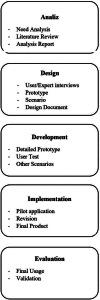Developing a virtual patient: design, usability, and learning effect in communication skills training
- PMID: 37993846
- PMCID: PMC10664539
- DOI: 10.1186/s12909-023-04860-7
Developing a virtual patient: design, usability, and learning effect in communication skills training
Abstract
Background: Literature shows that Virtual Patients (VPs) find extensive usage in the field of health sciences, especially in the post-pandemic period. VPs are successfully utilized in developing various effective skills like medical interview. However, this technology is quite new in Turkey and has not yet been used in communication skills training in a structured form. This research aimed to develop a virtual patient to improve the communication skills of medical students.
Methods: Developmental research method was used in the study. The implementation phase involved the one group posttest quasi-experimental design. The study group comprised of experts in various fields and 213 medical students. Needs Analysis Form, Scenario Building Form, System Validation Form, Communication Skills Assessment Form, and Interview Form were used as data collection tools. The research primarily concentrated on ensuring minimal errors within the system and enhancing students' communication skill scores.
Results: The study found that VP was effective in teaching communication skills. Communication skills improved from a mean score of 36.74 in the first interview with 15 students to 74.2 in the final application with 198 students. It was determined that the students who practiced repeatedly (n = 26) made 17% more effective interviews than their first practices (score: 89.2). The script matching of the VP was 83%. Other data obtained from the students generally showed that the VP application was developed in accordance with the purpose, that it was user-friendly, and that the scenarios were adequate.
Conclusion: VPs like this have the potential to develop skills such as history taking, clinical reasoning, etc., which are very important in the field of health sciences.
Keywords: Communication; History-taking; Simulation; Technology-enhanced teaching; Virtual human.
© 2023. The Author(s).
Conflict of interest statement
The authors declare no competing interests.
References
-
- Powell E, Turnbull J. Design and implementation of a curriculum to teach communication skills to pediatric critical care fellows. Acad Pediatr. 2016;16:45–7. doi: 10.1016/j.acap.2016.05.112. - DOI
MeSH terms
LinkOut - more resources
Full Text Sources


